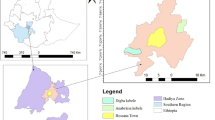Abstract
This paper explores the link between local knowledge and tree specie preference in the South Tongu District of Ghana. It is based on a field study that observed, inter alia, that even though Neem is not commonly promoted in Ghanaian afforestation programmes, it is highly popular in the area. Local farmers' preferences for tree species are governed by several factors –; suitability to local climate, availability and access to markets, perceived economic value and availability of wood fuel dependent enterprises. The survey further demonstrates that local knowledge is incorporated into decision-making regarding adaptation of farming practices to changing rainfall patterns; and also plays a role in influencing specie preference. Some likely implications, which these may have on conservation policy and planning in the study area, are also explained.
Similar content being viewed by others
References
Argyrous G., 1997: Statistics for Social Research. MacMillian Press Ltd., London, U.K.
Awumbila M., 1999: Fuelwood Utilization and Conservation among Fish Processors on the Coastal Zone of Ghana. Bulletin of the Ghana Geographical Association 21: 129–;136.
Bandyopadhyay A.K., 1997: A textbook of Agro-forestry with Applications. Vikas Publishing House PVT Ltd. New Delhi, India.
Binns T. (ed.), 1995: People and Environment in Africa. John Wiley and Sons Ltd., England.
Braimah A.K., 2002: Integrating indigenous knowledge and soil science to develop a national soil classification system for Nigeria. Agriculture and Human Values 19: 75–;80.
Chamberlain J.R., 2000: Framework for monitoring invasive tree species in Ghana. (see: http://www.Green.ox.au.uk./cnrd.)
Chambers R., 1983: Rural Development: Putting the Last First. Longman, Harlow.
Cline-Cole R.A., 1995: Livelihood, sustainable development and indigenous forestry in dryland Nigeria. In: Binns (ed.), People and Environment in Africa. John Wiley and Sons Ltd., England.
Colin J.E and Pussemier L.D., 1992: The Neem Azadirachta indica as a means to control soil nematodes and its application in vegetable cultures in Benin. Tropicultura 3, 89–;92.
District Forestry Official Records (DFOR), 2001: South Tongu District Forestry Department Official Records, March, 2001.
FAO, 1989: Women in Community Forestry: a field guide for project design and implementation, Rome
Foerster P.H., 2000: Regional Outlook: Present Situation in Using Neem trees in West Africa and Sahel. In: Brimah A.K. (ed.), Efficacy and Commercialisation of Neem Products. Proceedings of an Open Forum organized by the Goethe-Institut, Accra, 19–;21 October, 1999.
GWSC, 1992: Ghana Water and Sewerage Corporation. South Tongu District, Water and Sanitation Survey, 1992.
Gyimah A., 1997: Desiccation, Sensitivity and Storage of Neem Seeds, pp. 63–;69. In: Foerster P. (ed.), The Potentials of the Neem tree in Ghana. GTZ publication, 127 pp.
IIRR (International Institute of Rural Reconstruction), 1996: Recording and Using Indigenous knowledge: A Manual. IIRR, Silang, Cavite, Phillipines (www.panasia.org.sg/iirr/).
Kikula I.S., Christiansson C. and Mungóngó C. (eds), 1998: Man-Land inter-relationship in Semi-Arid Environments of Tanzania. Proceedings of the Dodoma Workshop. Working paper. Environment and Development Studies Unit (EDSU). Stockholm University, Sweden.
Koku J.E., 2001: Socio-Cultural Factors and Land Degradation in the South Tongu District of Ghana: Some Implications for Resource Protection and Environmental Health. Journal of Environmental Planning and Management 44(3), 309–;330.
Koku J.E. and Gustafsson J.-E., 2003: Local Institutions and Natural Resource Management in the South Tongu District of Ghana: A case study. Sustainable Development (11)(1): 17–;35.
Millar J. and Curtin A., 1999: The Nature and Role of Farmer Knowledge in Temperate Pasture Management in the Murray-Darling Basin. Rural Society. 9(1): 301–;312.
Mortimore, M., 1998: Roots in the African Dust: Sustaining the Dry lands. Cambridge University Press, Cambridge, U.K.
Nachmias C.F and Nachmias D.N., 1996: Research Methods in the Social Sciences. St Martins Press, Inc.
Ofori-Sarpong E., 1999: The Disappearance of Ghana's Forests: Causes and Problems of Rehabilitation. Bulletin of the Ghana Geographical Association 21: 47–;54.
Overseas Development Institute (ODI), 1998: Rethinking Natural Resources Degradation in Semi-Arid sub-Saharan Africa: The Case of semi-Arid Ghana. Study Report. University of Development Studies, TamaleGhana/Overseas Development Institute, London, U.K., pp. 63.
Radcliffe E., Ouedraogo G., Patten S., Ragsdale D. and Strzok P., 1996: Neem in Niger: A new context for a system of indigenous knowledge. In: Warren D.M, Slikerveer J.L and Brokensha (eds), The Cultural Dimension of Development, pp. 34–;70, ITDG.
Reij C., Scoones I. and Toulmin C. (eds), 1996: Sustaining The Soil: Indigenous Soil and water conservation in Africa. Earthscan Publications Ltd., London.
Schill P.F., Afreh-Nuamah K., Gold C.S. and Green K.R., 2000: Farmers' perception of constraints to plantain production in Ghana. International Journal of Sustainable Development and World Ecology 7: 12–;24.
Shiva V., 2002: Water Wars: Privatization, Pollution and Profit. Pluto Press, London.
Sikana P.A. and Mwambazi T.N., 1996: Environmental change and livelihood responses: shifting agricultural practices in the lakes depression zone of Northern Zambia. In: Reij C, Scoones I. and Toulmin C. (eds), Sustainable the Soil: Indigenous Soils and Water Conservation in Africa. Earthscan Publications, Ltd., London.
Songsore J., 2001: The decline of Rural Commons in Sub-saharan Africa: The case of Upper West Region of Ghana. In: Saaka Yakubu (ed.), Regionalism and Public policy in Northern Ghana. Peter Lang Publishing, Inc., New York, U.S.A.
STDA (South Tongu District Assembly), 1996: South Tongu District Socio-Economic Survey, SPRING/DoP, UST (Ghana).
Taabazuing J., 2000: The Neem activities of the church. Proceedings of an Open Forum organized by the Goethe-Institut, Accra, 19–;21 October 1999.
Veihe A., 2000: Sustainable Farming Practices: Ghanaian Farmers' Perception of Erosion and their use of Conservation Measures. Environmental Management 25(4): 393–;402.
Wilk J., 2000: Local Perceptions about Forests and Water in two Tropical Catchments. GeoJournal 50: 339–;347.
Yadav J.S.P., 1991: Problems and potentials of Reforestation of Salt-affected Soils, India. Social Forestry Research Digest 1(6): 1–;56.
Author information
Authors and Affiliations
Rights and permissions
About this article
Cite this article
Koku, J. Tree planting, local knowledge and species preference in the South Tongu District of Ghana: Some perspectives. GeoJournal 57, 227–239 (2002). https://doi.org/10.1023/B:GEJO.0000007218.44793.d7
Issue Date:
DOI: https://doi.org/10.1023/B:GEJO.0000007218.44793.d7




